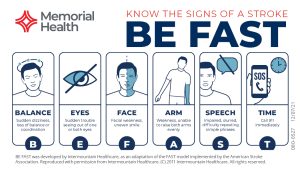Why Strokes Can Happen At Any Age and What You Can Do About It

While most strokes occur in persons over 65, it can happen at any age. Unfortunately, sometimes people do not recognize the symptoms of a stroke in younger individuals because they don’t think it’s possible.
Each year, 795,000 people suffer a stroke in the United States, and fortunately, it is preventable and treatable.
Manage Risk Factors
Aspirin: taking aspirin may help lower your risk for stroke. However, you should not take aspirin if you think you’re having a stroke. If you’re at risk, talk to your doctor about taking a daily aspirin.
High blood pressure: left uncontrolled, high blood pressure can cause a stroke in the long term. Follow your doctor’s recommendations, live an active lifestyle and eat a healthy diet to control your blood pressure.
High cholestrol: a high level of LDL cholesterol, or bad cholesterol, and low HDL cholesterol, or good cholesterol, can increase your risk for heart disease or stroke. Follow your doctor’s recommendations for lifestyle changes and medications to manage and treat cholesterol problems.
Quit smoking: smoking doubles your risk of dying from stroke. The more you smoke, the greater your risk. Quitting smoking can significantly reduce your risk. Learn more about smoking cessation classes in your area.
Increase physical activity: check with your doctor about the benefits of adding even a small amount of physical activity to your daily routine.
Take medications as prescribed: medication for atrial fibrillation is key in helping lower stroke risk.
Know Your Nearest Stroke Centers
Did you know? Hospitals can earn special stroke designations from The Joint Commission, the nation’s oldest and largest standards-setting and accrediting body in health care. Our hospitals have earned Comprehensive Stroke Center (SMH) and Primary Stroke Center (DMH) designations from The Joint Commission and Stroke Ready Hospital (JMH, LMH, TMH) designations from the Illinois Department of Public Health.
Identify a Stroke
Spotting a stroke is the first step toward stopping it.
If you identify problems while giving this simple test, call 911 and seek medical help immediately. The time you save could save your life or the life of someone you love. If you suspect stroke, remember B.E. F.A.S.T. = the Balance, Eyes, Face, Arm, Speech and Time Test. Learn to recognize a stroke because time lost is brain lost.
B.E. F.A.S.T.—the Balance, Eyes, Face, Arm, Speech and Time Test
Remembering B.E. F.A.S.T. is an easy way to quickly identify the early warning signs of a stroke.
BALANCE
Sudden dizziness, loss of balance or coordination.
EYES
Sudden trouble seeing out of one or both eyes.
FACE
First, check for facial weakness. An uneven smile or weakness on one side could mean trouble.
ARMS
Next, check for arm weakness. Inability to raise both arms evenly could be another sign.
SPEECH
Next, check for impaired speech. Slurred speech or difficulty repeating simple phrases could mean a stroke.
TIME
Finally, call 9-1-1 or get the individual to the hospital as soon as possible.
More ways to spot a stroke:
- Sudden weakness or numbness of face, arm or leg, especially on one side.
- Sudden confusion, trouble speaking or understanding.
- Sudden trouble seeing in one or both eyes.
- Sudden trouble walking, dizziness, loss of balance or coordination.
- Sudden, severe headache with no known cause.
Remember, every minute counts. Do not wait. Call 911.
If you believe someone is having a stroke…
Call 9-1-1 immediately and get to your nearest emergency room.